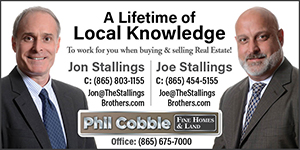Ballfield light update passes
Farragut Board of Mayor and Aldermen voted 2-1 to approve an ordinance that changes the Town’s lighting ordinance regarding ballfield lights on final reading during its meeting Thursday, Jan. 12.
While Mayor Ron Williams and Alderman Drew Burnettt voted in favor of the ordinance, Alderman David White, who voted against the change, reiterated his previous objections. Vice Mayor Louise Povlin and Alderman Scott Meyer were absent.
The ordinance now defines ballfield lights and adds exceptions for outdoor site lighting and restrictions.
Several months ago, Farragut Neighborhood Preservation Partnership submitted an application to add restrictions to the Town’s existing ordinance.
While there was an earlier ordinance draft, it came with concerns raised regarding zoning districts in the Town that would be affected by the changes.
“The Town attorney ended up working with the staff to develop the language that is in Ordinance 22-12,” Community Development director Mark Shipley said. “We shared that with the applicants, and they were satisfied with what was put together and were in support of the ordinance language.”
“We came together earlier (last year) to try to develop a proactive, constructive means to safeguard all Farragut residential neighborhoods,” said Jeanne Brykalski, a spokesperson for FNPP. “Our result of our almost year-long effort is this amendment that provides ground rules and structures to prevent incompatible or intrusive development … We had a lot of interaction with Town staff and our elected officials, who have worked diligently with us to guide us along this process, which we are extremely grateful for.”
Farragut Municipal Planning Commission voted to recommend approval of the ordinance, then the Board approved it in December on first reading with White casting the lone vote against Ordinance 22-12.
White, a critic of Ordinance 22-12, contended the ordinance was a way to deal with the lights at McFee Park’s basketball court, which he said was approved under the Town’s existing lighting ordinance that prohibited the lights.
“There’s a little more to this ordinance than people are understanding,” he said. He noted after the Town had submitted plans for a basketball court in McFee Park, and the plans passed.
“The only problem was it didn’t comply with the code that existed at the time that they are trying to change tonight,” White added, also noting the original code allowed only 28-foot lights in any facility, which included the Town parks.
“The group of concerned citizens that requested this change — and I think they were well-intended — they were worried about the 28-foot because they assumed that technology would change, and somebody could put 28- or less feet on a ballfield and just put more of them,” the alderman said. “They didn’t want that at all, and I don’t blame them.
“But this ordinance went way beyond that,” White said. “After the violation was brought to the attention of the mayor and the Town attorney, the mayor did what he was supposed to do. He asked the Town attorney for his opinion.
“And the Town attorney did what he was supposed to do,” White said. “He gave an opinion.”
But, White disagreed with that opinion.
“We’re setting ourselves above the law,” he argued then warned people living near Anchor Park, which does not permit lights as a result of a resolution years ago, “If you think you’re safe with the resolution, if this (ordinance) passes, you are at risk.”
“I do not believe that to be the case at all,” the mayor said. “It does not change any protection.”
Town attorney Tom Hale contended the Town did not violate its own code. He said it could put up the lights at McFee Park despite its lighting ordinance because, while there is no case law in Tennessee, the State Supreme Court would rule with the majority of other states that allow municipalities to take actions that would go against their own ordinances.
He agreed with Williams: “I don’t think the amendment changes the resolution for Anchor Park at all.”


